Deep Cycle Battery Alternative
From Merle Davies mp_davies@netzero.net
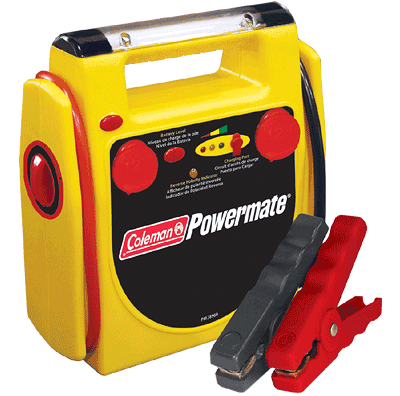
* 10 amp/hour maintenance-free battery
* 500 peak amps/250 cold cranking amps
* Reverse polarity indicator light and alarm for added protection
* Booster cable ON/OFF switch for added safety
* Built-in fluorescent worklight
* Dual 12-volt power ports for operating 12-volt accessoriesÉgreat for emergencies
* LED battery level indicator lights to signal when recharging is needed
* AC and DC charging adaptors included
UPC 6-62230-00896-8
Model # PMJ8960
Hi Electric Flyers,
I purchased a Coleman "Power Mate" Wet Battery and Charger combo for Electric Flight. It is 25% of the 45 lbs of my Marine Deep Cycle Battery now used. It will be much more comfortable moving about with my back problem. The unit has two (2) 12-volt power outlets for auto cigarette connection leads. The specifications on this unit, and others, can be found on their Web site www.teamproducts.com.
Radio Shack has item #270 - 1521 for $6.99. It seems well suited to assemble heavy charging leads between the power unit and cells to be charged. Trust this will be of aid to you in Electric Flying.
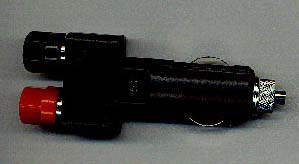
Radio Shack Adapter - #270 - 1521
Return to "What's In This Issue?"
More on the Ampeater
From Laurie Jones lhjones@supanet.com
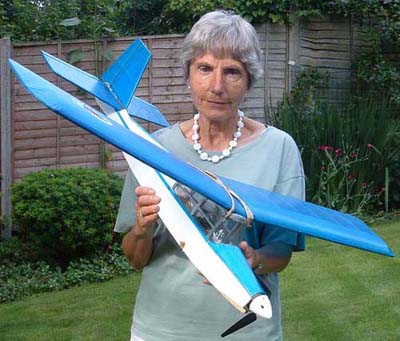
Dear Ken,
I haven't been in touch for a while, but appreciate getting access to Ampeer regularly.
I've had a great deal of fun flying the Ampeater this year and continue to be pleased with it.
A few weeks ago I decided it would be improved if I took off the wheels (it's so easy to hand launch anyway) and fitted a folding prop.
I also added a removable skid under the nose to take the landings and to restore the C of G after removal of the U/C.
The result is much better penetration in breezy weather, and a much-improved glide. The chunky wheels must have contributed a lot of drag.
The other result is a much more marked nose-up attitude under power, needing some down trim. However, it does now pick up lift if it is going. We had thermally weather today with gusty conditions under good cumulus, and there was good lift about. I'm not good at staying in it very long, but had some quite long flights. It's not anywhere near a sailplane, but does stay up quite well. On the other hand it's fun to fly as a 'park fly' doing slow low circles around me. (No-one else at the field, so no need to observe the protocol of the power fliers' strip, pits etc).
Flights are generally about 20 min, and today I was up for half an hour. The current set-up draws about 9 amps at 7800 rpm (static) on an 8.5 x 4 folding prop and 2.33:1 gearbox. Power is from an 8-cell 1300KR NiMH battery, That gives about 10 min at full throttle before the ESC kicks in, but 'climb and glide' sequences or low-power circuits provide twice that on most flights.
I've got somewhere near to doing stall turns, and consecutive loops are easy from level flight once up to speed. With the wheels on it needed a dive to get enough speed for a loop.
This afternoon I got it close to trim for free flight. The nose-up under power means it needs to do left hand circles to avoid the stall, and on the glide the trim is about right to continue turning left in wider circles. I tried left hand power circuits (against torque), but the glide was a spiral descent. The only problem of course is that it goes downwind rather fast, so has to be guided back with the radio. But it would make a classic free-flight model.
I've attached a couple of pictures with the new set-up. Persuaded my wife to pose with the model too. She did take some video of it in flight using my digital camera. Quality is not very good and file size a bit big, but I could send some flying shots if you were interested. I'll be on a broadband connection soon (I hope) so sending a few Mb won't be so expensive and time-consuming.
Return to "What's In This Issue?"
NEAT Fair 2004 Reminder
From Tom Hunt neatfair@optonline.net
Hello Friends,
The 2004 NEAT Fair, Sept. 17, 18, 19, pre-registration of pilots and reservations for the Friday night Kick-off dinner are on the NEAT Fair website at: www.neatfair.org
Return to "What's In This Issue?"
Big-T
From Crash Siegel crashsiegel@yahoo.com
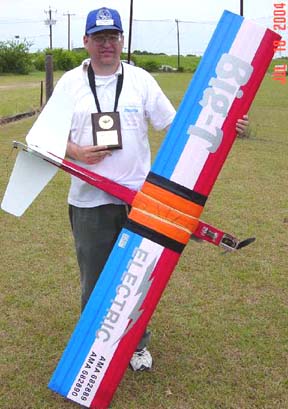
Ken,
I have attached a picture of me and my Big-T (and the "Largest Small Plane" trophy for our club's PopGun 2004 event). This is the plane I, and a number of others, flew for 36 minutes on one pack - not just circling but every kind in insanity you can do with a 3 channel! Some of the guys had never flown electric before and were quite impressed with Big-T. I bobbled the final approach and went around with plenty of energy (looped from level several times) then landed it OK. After the flight, the 7.8Ah pack took 6.8Ah to fully recharge (Orbit V6.3). Could have flown 40 minutes easy.
Details: JKA Big-T (72" wingspan, 792 sq in WA, 102oz AUW), JR R600 Rx, Hitec HS81MG servos (2), Air Alert crash locator, UBEC, MAS 12x8E (or APC 12x8E - break easier but more efficient), AXI 4120/14 on Esprit Models alum motor mount, Castle Creations 45A controller, TP 4S4P 7.8Ah (and 8.2Ah) Li-Po packs.
Static numbers for 7.8Ah pack and APC 12x8E: 39.5A, 14.0V, 550W, 7,920 RPM. The 12xRC2400 pack was: 32.2A, 12.5V, 396W, 7,260 RPM (4 oz heavier, would fly ok but didn't have the WOW! factor of the Li-Po's).
Crash Siegel
San Antonio Prop Buster
Folks, this is the way to give information! Most of the magazines don't do this in a review. They don't give the prop, RPM, amp draw and volts for the power system. To me, this is essential information. Thanks "Crash" for the very useful info. Great job! KM
Return to "What's In This Issue?"
Li-Po for Big Cessna
From Zen Tomaras Z tomaras@aol.com
I need some help in determining how many Li-Po's I need for my Cessna. The plane weighs 7 lbs and is powered by 20, 3000 NiMH batteries the power plant is a MaxCim brushless DC motor-1472 rpm/volt-28 cells Max and a 3.33:1 gearbox with a digital speed controller. I would your input on what to order.
For a plane with this power system you can divide the number of cells you are using by 3.5 to estimate the number of Li-Po's you'll need.
20/3.5 = 5.71
5.71 indicates that a 6S (series) pack would be indicated. A 5S might be okay, as the plane can be lighter with Li-Po batteries aboard, but your amp draw will be down, as well as voltage when using a 5S pack.
With the amp draw between 30 and 40 amps, the Kokam high discharge would be indicated, to keep the "pack" as light as possible. A Kokam 2100mAh 6S1P pack would weigh about 17.9 oz. You're NiMH pack probably weighs about 42 oz. The flight time might be about the same, even with a 2100mAh rating on the Li-Po pack, since you'll be able to throttle back more and the plane will be lighter. If you want to increase your flight time, parallel another pack. That would increase the capacity to 4200mAh, but it doubles your expense. The 6S2P 4.2Ah pack would weigh about 35.8 oz. That is still a weight savings over the NiMH pack.
If it was me, I'd not parallel the pack in the plane, but have two separate packs, with the second one ready to go at the field.
The other option would be to try a 5S1P. The pack would weigh about 15.5 oz. That would be a tremendous weight savings and would probably offset the lower voltage and amp draw.
My recommendation would be to purchase a 3S1P and 2S1P pack of High Discharge Kokams and put them in series and give them a try. Don't forget that using a lower gear ratio can also bring your amps back up. If the 5S1P pack doesn't give you the performance you desire, then order another 3S1P pack. You can always use the 2S1P pack with another project. Once you have the performance you want, you can get another pack to field swap. KM
Return to "What's In This Issue?"
Reviewing the Reviews: Top Creations R/C's "Little Looper Plus"
By Ken Myers
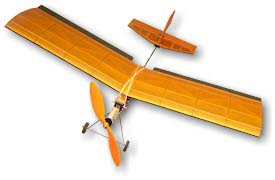
Photo from Top Creations R/C Web site
Reviewing the Reviews: Paul Susbauer reviewed Top Creations R/C's (www.topcreationsrc.com) "Little Looper Plus" slow flyer / park flyer in the August 2004 issue of Quiet Flyer, p 60-63.
The photo from the Web site indicates that this is a "stik-type" plane with ailerons. According to the Top Creations R/C Web site: "The Little Looper Plus is a spirited performer with smooth handling characteristics. In your local schoolyard or baseball field, this little guy can be a great trainer for beginners or add some aerobatic spice for folks who want something more out of a park flyer."
Paul's review was outstanding because of the plethora of useful information. The sidebar, as well as the article, included all of the information required to make an informed decision as to whether to purchase this model aircraft kit, as well as the components used by the reviewer. If only all reviews could include this much useful information!
When I read a review, not only am I interested in the model being reviewed, but also I am very interested in the exact equipment used to power and guide model. Weights and measures are also very important to me, as I use them to help guide me in equipment selections for other similar projects.
Paul chose to use the Apogee 2S1P 830mAh Li-Po pack as a power source ($26.00 from PFM Distribution Inc. - www.pfmdistribution.com). Using these Li-Po cells instead of 700mAh NiMH, as recommended by the manufacturer, resulted in a 1.3-ounce weight savings for Paul's 9.7 oz. version when compared to the 11 oz. NiMH version quoted on the Top Creations R/C's Web site.
Weights Worth Noting
AUW as reviewed: 9.7 oz or 275g
2-cell Apogee 830 Li-Po: 1.48 oz or 42g (15.3% AUW) GWS GW/EPS-300C (C) 5.33:1: 2.22 oz or 63g (22.9% AUW)
Total weight of battery, motor, gearbox & prop: 4.0 oz or 113.4 (41.24% AUW)
4 channel onboard radio components, as describe in review: 1.56 oz or 44.22g (16% AUW)
Completed Airframe Weight: 4.14 oz or 117.4g (42.7% AUW)
With a wing area of 310 sq.in. reported and a 9.7 oz AUW, the wing loading comes to 4.5 oz/sq.ft. or 13.75 dmsq.
Paul noted that, "From a packed dirt surface, rise-off-ground (ROG) takeoffs were performed in less than 15 ft. Although the climb out was very good, the overall top speed of the Little Looper was somewhat limited, which is perfect for a beginner/intermediate pilot."
He reported that his input power was 56 watts. That translates to about 92 watts of input power per pound. At a reported 8 amp draw and 7 volts input running through a Castle Creations 20P ESC (www.castlecreations.com), the supplied GWS GW/EPS-300C (C) is about 60% - 65% efficient. Watts out should be about 34+ supplied to the provided GWS 10 x 4.7 prop. That is about 56+ watts out per pound. It is not surprising that Paul said, "Loops were very tight, though rolls were a little sluggish."
While he noted that the top speed was "somewhat limited" (4,500 RPM * 4.7 pitch = about 21 MPH) this is an asset for a beginner. Another point that Paul made was that, "... the Little Looper Plus is one of the easiest planes to land, as it comes in very stable and slow,..."
If you are looking for a 4-channel slow / park flyer, check out Paul's full review. This just might be the one you are looking for. Be sure to check out Top Creations R/C's Web site.
Return to "What's In This Issue?"
Why Can't They?!?
By Ken Myers
I'm going to "harp" on one of my pet peeves, the lack of useful information on manufacturers and suppliers' Web pages. Please note that there is NOTHING WRONG with the supplier I mention in this editorial, they just lack, in MY opinion, useful information posted to their Web site. For all I know, the information could be in their instruction manual, but that doesn't help me if I don't have it!
While visiting the Top Creations R/C Web site in researching Paul's article, I was looking for information on the "Little Looper Plus". The site had ONLY the following posted on July 31, 2004.
Specifications
Wing Span: 33"
Length: 28"
Weight: 8 oz. without battery
11 oz. with battery
Wing Area: 310 sq. in. (2.15 sq. ft.)
Wing Loading: 4.5 oz. / sq. ft.
Motor: 370 - Geared 5.33:1
Includes: Motor & Prop
Kit Price: $ 63.00
What's Missing?
Battery? What battery? It doesn't say. From reading Paul's article, I found out that the manufacturer recommends a 7- to 8-cell NiMH battery or 2-cell Li-Poly. I have to assume that Paul read that information in the instructions for the kit. Top Creations R/C does not sell a 7-cell NiMH battery. There are 8-cell packs of 700mAh HECELL's available; therefore one can assume this is what the manufacturer is recommending. The weight for the 8-cell NiMH pack is given as 3.5 oz.
Weight? The difference between the airframe and radio weight (8 oz.) and the AUW (11 oz.) is 3 oz. The available battery weighs 3.5 oz. See the conflict? Yes 0.5 oz. is really nothing, but things should be consistent!
The manufacturer/supplier should give the EXACT details as to what was used in the model they got their data from.
Searching the site, I found that a GWS 4-ch is available, as well as GWS Pico servos. There are 3 possible ESC's that could have been used. What on earth was used?
I believe a more useful listing of Web site information would be something like this: (please remember that this is MADE UP and not from Top Creations R/C's Web site! - this is only used as an example here based on information I found while viewing different areas of the Top Creations R/C's Web site)
Specifications
Wing Area: 310 sq. in. (2.15 sq. ft.) <moved to the top, as it is one of the very most important aspects about the plane>
Wing Loading at AUW listed below: 5.24 oz. / sq. ft. <moved next to the top because, along with a photo of the plane, this is a major descriptor of the "type" of model this is>
Wing Span: 33"
Length: 28"
Weights:
Completed airframe weight - using SolarFilm Lite Covering - (4.15 oz.)
Airborne radio weight - using GWS R-4P 4 Channel Receiver (0.16 oz.), 3 ea. GWS Pico BB Servo (0.22 oz ea = 0.66 oz., Castle Creations Pixie 20P (0.3) - (1.12 oz.)
Included Motor & Prop: GWS GW/EPS-300C (C) geared 5.33:1 (2.2 oz.), GWS Slow Flyer 10 x 4.7 (0.3 oz.) - (2.5 oz.)
Weight without battery: 7.75 oz.
Battery: 8-cell 700mAh NiMH HECELL pack - (3.5 oz.)
AUW with suggested equipment: 11.25 oz.
Radio airborne components and batteries are available directly from us
Kit Price: $63.00
Of course they'd have to put a legal disclosure that your model would be different, but that's become standard fair today.
Come on manufacturers and suppliers, PLEASE give us the useful information we need!
Return to "What's In This Issue?"
Using the Graupner Ultra 3300-7
From Keith Shaw keithshaw98@charter.net
Please note: this is NOT THE KEITH SHAW of Ann Arbor, MI. This gentleman just happens to have the same name. Please don't besiege him with your eflight questions. KM
Hi Ken!
My name is also Keith Shaw, but I live just south of Atlanta, Ga., though I've seen Keith Shaw of Ann Arbor, MI mentioned many times in the AMA publications. I've thought many times of trying to contact him just to say, "Hey, we have the same name!" But I have also found recently that at least 24 other people in the US also have that name, so.....
Anyway, I have a question regarding a brushed motor and ESC I own from Graupner. I certainly hope you can help. The motor was originally bought for an electric helicopter, but I didn't have much luck with it, so I want to use it in an airplane application. The motor is a 3300-7 Ultra and the ESC is a MOS. I do not know the specifics of both except that the ESC requires 30 cells and has a low voltage cut off.
I would like to know what class of motor this falls under...i.e., 400-600 or larger and do you know of any planes available, either ARF or kit or plans that I could use this motor with?
Thanks,
Keith Shaw
The Ultra 3300-7 comes in two versions:
Ultra 3300-7 20v #6354 Kv: 578 Io: 2.8 Ra: 0.098 Wt.: 18.2 oz.
Ultra 3300-7H 20v #6354 Kv: 574 Io: 2.02 Ra: 0.071 Wt.: 18.7 oz.
Since the data is so close on both of them, it shouldn't make too much difference which version you have. The motor is way larger than a Speed 600!!!
Using 18 cells (GP3300 or Sanyo CP-2400), an 11x6 Master Airscrew standard wooden prop should draw about 25 to 30 amps and spin at approximately 9,000 RPM. That would put the plane's speed, depending on the airfoil and plane design, at between 50 MPH and 55 MPH.
With about 450 watts of input power, at the amp draw previously mentioned, the motor appears to be about 75% efficient. With the power system weighing about 54 ounces an all-up-weight (AUW) of about 108 oz. or less is suggested. With an 11 oz. onboard radio weight of four standard servos, receiver and receiver battery, that leaves about 43 ounces for your finished airframe weight. A good wing loading for this size plane is about 20 oz. - 25 oz. per square foot. That means a wing area of 5.4 sq.ft (778 sq.in.) down to 4.32 sq.ft. (622 sq.in.) would be appropriate. This information gives you some general guidelines in your search for an airframe.
If you'd like a "floaty" type plane, a Sig LT-40, with 900 sq.in. would work with this power system. A Hobbico NexSTAR 46 (722 sq.in.) would be a typical airframe and type for the 20 oz./sq.ft. wing loading, while the Goldberg Tiger 2 ARF (680 sq.in.) would be typical of the closer to 25 oz./sq.ft. airframe and type.
These planes mentioned were chosen just to give you an idea of what to look for, not because I recommend them for any particular reason. I have no firsthand knowledge of either the NexSTAR or ARF version of the Tiger.
Your ESC should be fine with the prop and number of cells I've indicated. KM
Return to "What's In This Issue?"
New Denver E-Club
From Ron Evans RMEFRBE@aol.com
I'm writing to update you on a new all electric club in the greater Denver area, The Rocky Mountain Electric Flyers. Our AMA charter began in February 2004 #4525 and we now have 35 AMA club members as well as quite a few "guests" and friends flying with us. The club web site is www.rmeflyers.org. We are mostly sport flyers with a few ex-glow guys who are a bit more type A. Planes range from Sticks to Hotliners, helis, GWS stuff, a couple powered gliders and lately more lipo/brushless 3D foamies. We've had write-ups in July 2004 Quiet Flyer p 32 and September Model Aviation p 102.
I am the Vice president and my home phone [evenings] is 720 220 3384. Ron Evans rmefrbe@aol.com
Return to "What's In This Issue?"
Kyosho's Spree Sport in Portugal
From Paulo "Chispas" Faustino chispas@sapo.pt
Dear Ken:
Thanks for another number of your superb magazine. Great to see "King Crimson" of the "Great Bearded One", Keith Shaw, is still in great fashion. Is it possible that he can give away a plan of it?
Sorry, Keith makes no plans of his great planes. He only draws enough to create them. KM
The Spree Sport comes with a 380-class motor with a 1.7:1 gearbox but in the movie I sent you it has an Multiplex Permax 480 and 7 1100 NiMH cells. It is a little underpowered but flyable (the Ezone has an review of it). Now is flying with a Multiplex Permax 450 Turbo, geared 1.85:1, Cam 9x6 prop and 8 1760 Panasonic cells. It now weighs 3 ounces more but faces the wind with more authority and is much more aerobatic.
With my best regards, have smooth landings.
Paulo "Chispas" Faustino
Return to "What's In This Issue?"
Looking for Silk?
I recently had a gentleman email me with the question of where to purchase silk to finish his plane with. The only place that I knew of was Sig Manufacturing. He came back with the following information. KM
Here is a website, www.thaisilks.com, a friend sent me for silk runs from I think $3.75 a yard to around $5 something a yard. That's a lot cheaper than Sig's 12 dollars a square yard.
Catalog numbers on that are #026A, 026L, or 021F. You may want to check that out and then pass it on to the rest of the gang.
John
Return to "What's In This Issue?"
Mountain Models Tantrum 3D
http://www.mountain.models.com
By David Stacer dstacer@dsemail.com
EFO Member
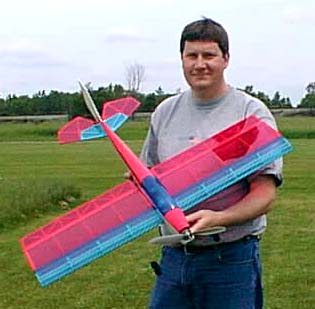
Wingspan: 37" [940mm]
Length: 37" [940mm]
Wing area: 370 sq.in. [23.87 dmsq] - (MM site)
AUW: 16.7 oz [473g] (as reviewed)
Wing Area Loading: 6.5 oz./sq.ft. [19.82g/dmsq]
Cubic Wing Loading: 4.05 oz./cu.ft.
Weight without battery: 12.9 oz [366g]
Completed Airframe Weight: 7.8 oz [221g] (47% AUW)
Motor: AXI 2112/34 - 2 oz [57g]
Kv = 740 Rm =0.345 Io = 0.4
Prop: 12 x 6 APC Slowfly - 0.4 oz [11g]
Battery: Kokam 3S1P 1500 LiPo (8C/12 amp discharge, internal impedance per cell 71mOhm) - 4 oz [113g]
Total Power System Weight: 6.4 oz [181g] (38% AUW)
Speed Controller: Castle Creations Phoenix 25 - 0.6 oz [17g], resistance - 6.5mOhms
Servos: 4 Waypoint 9-gram servos - 0.32 [9g] ea.
Receiver: Hitec Electron 6 = 0.6 oz (17g)
Total Onboard Radio System Weight: 2.5 oz [71g] (15% AUW)
Amps: 10.1 (measured)
Input Watts: 101
RPM: 5,220 (measured)
Building the Mountain Model Tantrum was very easy. The instructions were clear, just make sure to read them. The laser cut parts fit perfectly. The rudder and stabilizer are built up with laser cut parts that interlock like puzzle pieces. The fit on these pieces are incredible. To build the wings, the ribs interlock on the vertical spar then once the ribs are glued in place the spar caps go on. You end up with wings that are very light but very strong. The only building trouble I had was assembling the canopy. This was my first model that had a canopy and it was the most difficult part for me. Mountain models sells replacement canopies, so I guess I'm not the only one with canopy assembly problems.
I covered it with Neilson Lite. As you have said in the past it's a little difficult to work with but if you take your time you end up with a nice looking job that doesn't add too much weight.
The stock motor mount is the GWS square stick type of mount. I found a great motor mount from Stevens AeroModel (http://www.stevensaero.com/e-flight_blmounts.html). This is a laser cut mount that will mount the AXI motor to the square mounting stick. They have them available for many different styles of motors.
The servos are Waypoint 9 gram servos (http://www.foamfly.com). The Waypoints are very inexpensive as compared to the big named servos and I've used them in various models without any problem (so far).
I selected the AXI 2112/34 motor and, after trying a few different props, I have settled on the 12x6 APC Slowfly. With this motor on a Kokam 3S1P 1500 pack the Tantrum will go vertical on about 3/4 throttle.
It's been lots of fun to fly. It takes off in about five feet and just goes wherever you point it. My skills have been steadily improving after flying it for a few months.
The First Flights
Rick and I met around 11 today - left for home at 4:00.
We must have gotten in 28-30+ flights. There were a few glow guys there on and off through out the day, but most of them only flew a little. Most of them spent most of their time trying to get their engines to run.
The slight breeze was a little shifty, but it was so light it really didn't matter.
Rick took up my Tantrum on its maiden flight. After he got it up and checked it out, he handed the transmitter over to me. Wow, what a great airplane! It will just go in whatever direction you point it. He thought it was great too.
We had a great day.
URLS:
Kit from Mountain Models www.mountain.models.com
Motor mount www.stevensaero.com/e-flight_blmounts.html
Waypoint servos purchased from: www.foamfly.com
Return to "What's In This Issue?"
August EFO Flying Meeting
The meeting was held at the Midwest field on a beautiful Saturday, August 7. There was a lot of flying going on, both glow and electric, as many Midwest members were there.
I was very happy to get my Vertical RC CAP 232 back into the air, as Sunday was to be the PMAC electric meet.
The September EFO flying meeting will be held on Saturday, September 4. Remember, you must have your AMA card with you to fly. See you then.
Return to "What's In This Issue?"
The Pontiac Miniature Aircraft Club Electric Fly
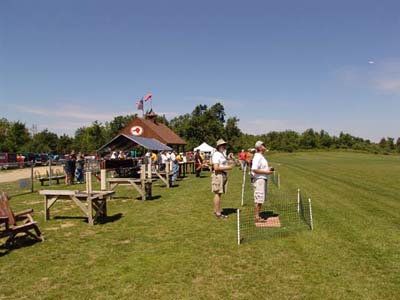
The weather on Sunday, August 8, couldn't have been better. Sterling Smith (Smitty) and the members of PMAC had the field in great shape and plenty of help on hand to provide a great day of e-flying.
There were 32 registered pilots. That is just the right size meet for lots of flying by lots of folks.
It was interesting to note that the majority of the aircraft flying at this meet were of the foam variety. I was amazed at the number of Vertical RC planes there, like my CAP 232, since they've been out of business for over a year. Luckily, the winds were very light, and almost anything was able to take to the air, including a great little Comet kit Fokker D-VII by Dave Keats.
Keith Shaw and Jim Young provided inspiration with their scale planes. There was also a very nice Sig LT-40 powered by a deWalt motor and Modelair-Tech belt drive. I hadn't seen this combination in several years, but it certainly works well with this plane.
I was very pleased to see a nice turnout of EFO members there.
PMAC should be very proud of this meet and the hard work by their membership. This was the second year for the meet, and it doubled pilot attendance. Keep up the great work PMAC!
Return to "What's In This Issue?"
Porterfield Collegiate & Amptique For Sale
Unfortunately, EFO club member, Ernie LaBelle has to give up flying. He is offering the following items for sale. These items will NOT BE SHIPPED! If you live within a one-hour drive of Waterford, MI, about 60 miles, I will be happy to bring the items to you. Both planes were flown last year. I would recommend that you put new batteries in the transmitters and use new receiver batteries in the aircraft. The best way to contact me is via email, kmyersefo@aol.com. I would prefer to sell the planes as "units", but will consider separate sales. Asking prices for the individual items are listed after the description with the unit price at the end.
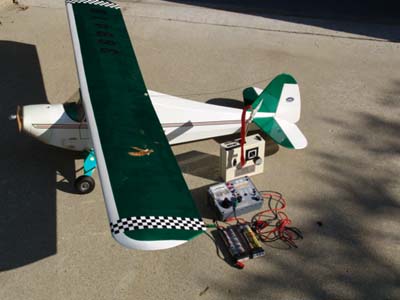
Porterfield Collegiate nicely built semi-scale by an excellent craftsman: $95.00
Astro Flight Geared 25 cobalt about 10 flights on it: $135.00
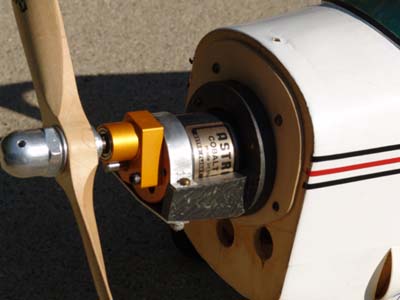
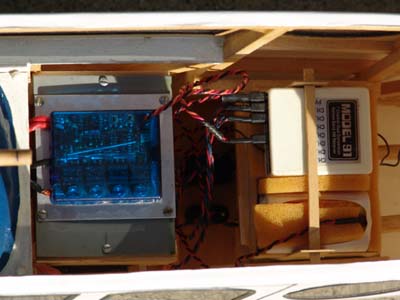
ACE Olympic V Single-stick (gold stickered), Ace 810 receiver, 3 Ace servos, rec. pack and charger: $100.00
Jomar SM-4 ESC: $50.00
1 14-cell Sanyo RC2000 NiCad power pack (2 7-cell packs in series): $50.00
Astro Flight 112 charger NIB (not the PK version): $68.00
If all of the Porterfield equipment is purchased as a single, take it all package: $250.00

Amptique 3-channel trainer/sport plane, excellently constructed, flies GREAT!: $50
Astro Flight 05 geared: $128.00


ACE Olympic V dual-stick (gold stickered), Model 91 receiver, 2 Ace servos, rec. pack and charger: $100.00
Jomar MiniMax ESC: $40.00
Hitec 315PK charger (peak charger for 5-7 cells): $40.00
3 7-cell Sanyo 800AR flight batteries: $20 each/$60 for all three
If all of the Amptique equipment is purchased as a single, take it all package: $200.00
1 only 7-cell Sanyo RC-1700 pack: $10.00
Return to "What's In This Issue?"
|














